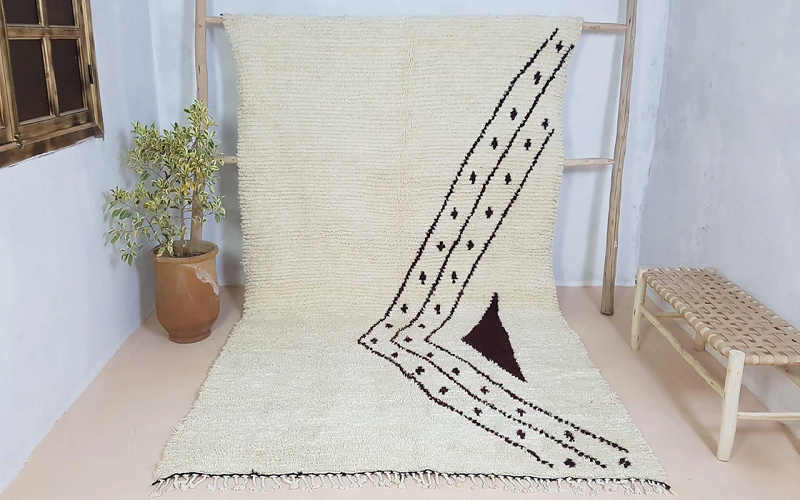The Cultural History Of The Beni Ourain Rug
Introduction
Ah, the Beni Ourain rug – a timeless piece of art that’s become a staple in modern homes. But there’s more to these beautiful rugs than meets the eye. They carry a rich cultural history that dates back centuries. So, let’s dive into the fascinating world of the Beni Ourain rug, where tradition, craftsmanship, and symbolism intertwine.
Origins of the Beni Ourain Rug
The story of the Beni Ourain rug begins in the rugged landscapes of Morocco. These rugs are the creations of the Berber tribes, specifically the Beni Ourain people, who reside in the Atlas Mountains.
The Berber Tribes
The Berber tribes, also known as the Amazigh, are indigenous to North Africa. They’ve lived in this region for thousands of years, passing down their customs and traditions through generations. The Beni Ourain tribe, in particular, is known for their exquisite rug-making skills.
The Atlas Mountains
Nestled in the Atlas Mountains, the Beni Ourain tribe finds inspiration from their surroundings. The harsh yet beautiful terrain, with its snow-capped peaks and verdant valleys, plays a crucial role in the creation of these rugs.
Craftsmanship and Materials
When it comes to crafting a Beni Ourain rug, the process is nothing short of meticulous. It all starts with the wool, which comes from the sheep that roam the Atlas Mountains.
Sheep and Wool
The wool used in Beni Ourain rugs is renowned for its quality. The sheep are raised in high altitudes, resulting in thick, warm wool that’s perfect for weaving. This wool is hand-spun, maintaining its natural oils, which gives the rugs their characteristic softness and durability.
Traditional Weaving Techniques
The weaving techniques used are as ancient as the tribe itself. Hand-woven on looms, each rug is a labour of love, often taking several months to complete. The weavers, predominantly women, use methods passed down from their ancestors, ensuring each piece is unique and steeped in tradition.
Symbolism in Design
One of the most intriguing aspects of the Beni Ourain rug is its design. The patterns are not just for aesthetics; they hold deep cultural significance.
Geometric Patterns
The geometric patterns seen on these rugs are more than mere decoration. They represent stories, beliefs, and aspects of daily life. From simple lines to intricate shapes, each pattern has a meaning, often rooted in protection, fertility, and nature.
Cultural Significance
The designs often reflect the weaver’s personal experiences and emotions. It’s a form of storytelling, where every knot and weave carries a part of their history. This cultural richness adds an extra layer of beauty to the Beni Ourain rug.
Beni Ourain Rugs in Modern Decor
Despite their ancient origins, Beni Ourain rugs have found a place in contemporary homes around the world. Their minimalist and neutral designs make them incredibly versatile.
Global Popularity
In recent years, these rugs have surged in popularity. Interior designers and homeowners alike appreciate their aesthetic appeal and cultural heritage. You’ll often spot them in chic apartments in New York, cosy cottages in England, and everywhere in between.
Interior Design Trends
The neutral tones and simple patterns of Beni Ourain rugs complement various interior styles, from Scandinavian to bohemian. They add warmth and texture to any space, making them a favourite among design enthusiasts.
Ethical Considerations
As with any traditional craft, it’s essential to consider the ethical implications of purchasing a Beni Ourain rug.
Fair Trade Practices
Supporting fair trade practices ensures that the weavers receive fair compensation for their work. This, in turn, helps preserve their way of life and keeps the tradition alive. When buying a Beni Ourain rug, look for sellers who prioritise ethical sourcing.
Sustainability
The sustainability of these rugs is another factor to consider. Made from natural materials and hand-woven without the use of machines, Beni Ourain rugs have a low environmental impact. Opting for a handmade rug over a mass-produced one is a more eco-friendly choice. Always buy your rug from a reputable retailer such as City Cows to ensure quality.
Conclusion
The Beni Ourain rug is more than just a floor covering; it’s a piece of history, a work of art, and a testament to the enduring spirit of the Berber tribes. By understanding and appreciating the cultural heritage behind these rugs, we can better value their beauty and craftsmanship. So next time you see a Beni Ourain rug, remember – it’s a story woven in wool.
FAQs
Q: What makes Beni Ourain rugs unique?
Beni Ourain rugs are unique due to their high-quality wool, traditional weaving techniques, and culturally significant geometric patterns. Each rug tells a story and is a one-of-a-kind piece of art.
Q: Are Beni Ourain rugs suitable for all decor styles?
Yes, their neutral tones and simple designs make them versatile and suitable for various decor styles, from modern to rustic.
Q: How can I ensure I’m buying an ethically sourced Beni Ourain rug?
Look for sellers who support fair trade practices and provide information about the weavers and their communities.
Q: What is the best way to care for a Beni Ourain rug?
Regular vacuuming and occasional professional cleaning are recommended to keep the rug in good condition. Avoid harsh chemicals to preserve the natural wool fibres.
Q: Can I use a Beni Ourain rug in high-traffic areas?
While they are durable, it’s best to use them in low to medium-traffic areas to maintain their appearance and longevity.


Leave a Reply
You must be logged in to post a comment.